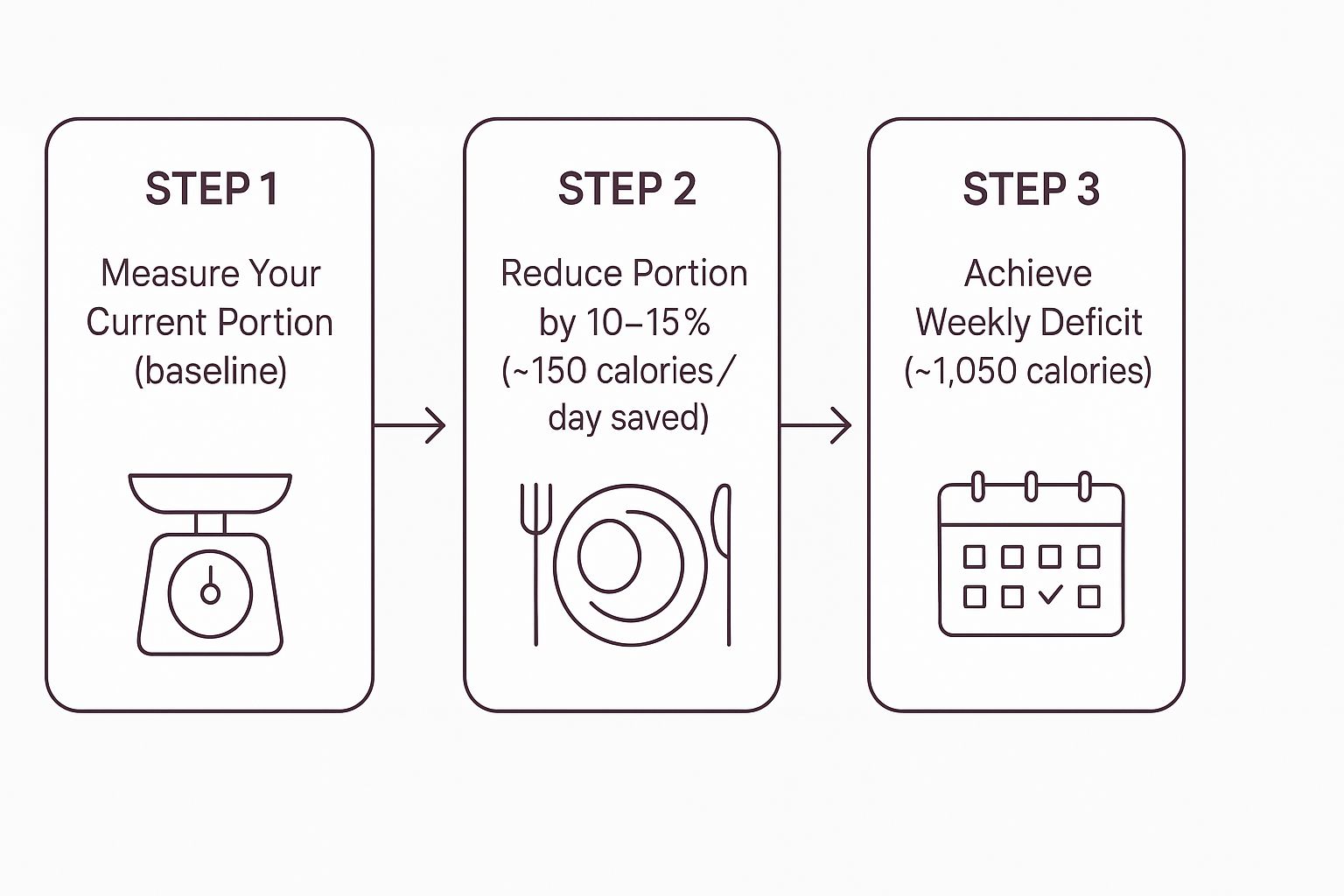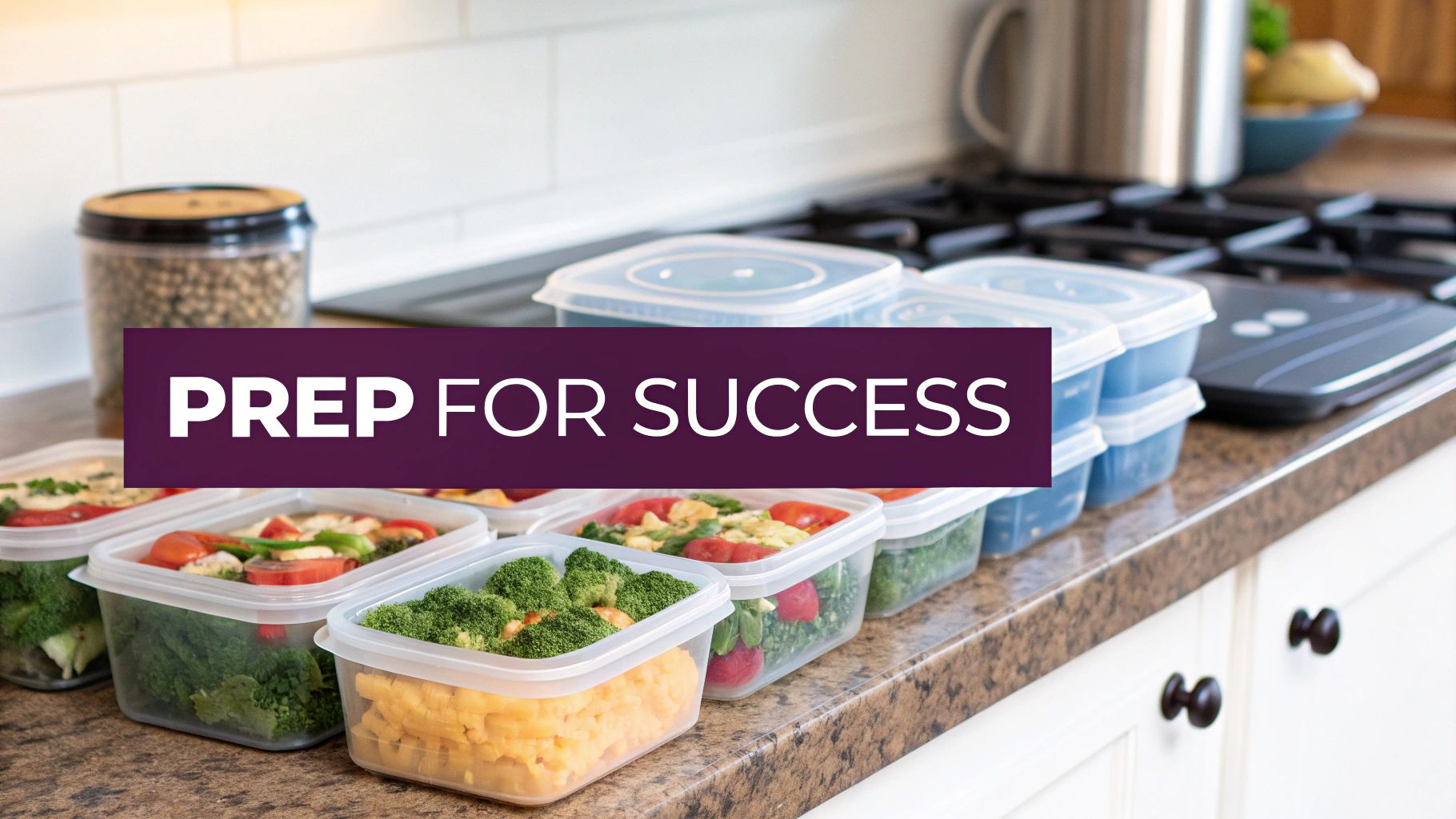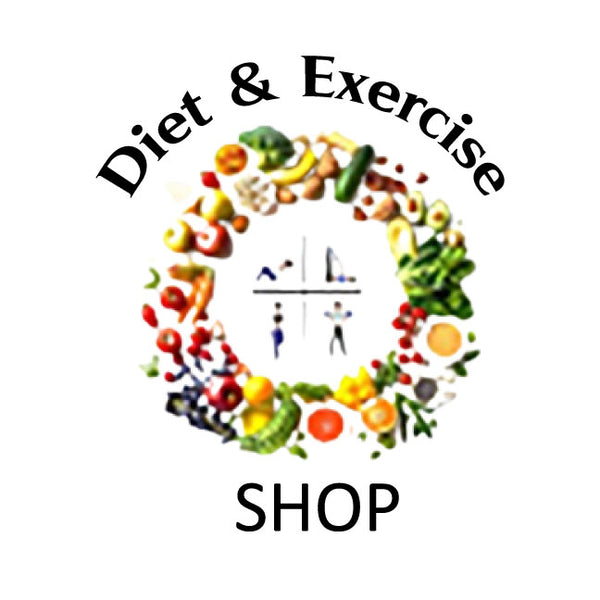
How to Portion Control for Weight Loss: Simple Tips to Succeed
The secret to getting portion control right for weight loss isn't about deprivation—it's about awareness. It’s understanding that how much you eat can be even more important than what you eat.
This isn't some restrictive diet; it's a practical skill that puts you in the driver's seat for sustainable results.
Why Portion Control is the Real Game-Changer for Weight Loss
Let's be real for a moment. You're trying to eat healthy—picking the salads, grilling the chicken—but the scale just isn't budging. Sound familiar? Often, the missing piece of the puzzle isn't the type of food, but the sheer amount of it on your plate.
By simply dialing back your serving sizes, you can create a significant calorie deficit over time without feeling like you're missing out. It’s about turning a common frustration into your biggest strength.
The Surprising Power of Small Tweaks
You don't need to radically change everything at once. In fact, tiny, almost unnoticeable adjustments are what stick for the long haul.
Think about this: studies have shown that people who actively practice portion control can slash their daily calorie intake by 25% to 30%.
That small change alone can lead to a steady, healthy weight loss of one to two pounds per week. It all adds up.

This visual guide breaks down just how impactful those small reductions can be over a week. As you can see, even trimming just 10-15% from your usual servings can save you over 1,000 calories a week. That’s the kind of change that moves the needle without a huge sacrifice.
A Proven and Practical Strategy
Portion control has always been a cornerstone of effective weight management, and for good reason—it works. With obesity rates on the rise, mastering this skill is more critical than ever.
When you pair this powerful habit with regular exercise, you create a complete and incredibly effective strategy for hitting your health goals.
Sometimes, the hardest part is just knowing what a "normal" serving size looks like. This quick guide uses everyday objects to help you eyeball your portions without needing a measuring cup.
Quick Guide to Everyday Serving Sizes
| Food Group | Serving Size | Easy Visual Cue |
|---|---|---|
| Protein (Meat, Fish, Poultry) | 3 ounces | Deck of cards |
| Cooked Pasta or Rice | 1/2 cup | A computer mouse |
| Cheese | 1.5 ounces | A pair of dice |
| Fats (Butter, Oil, Mayo) | 1 teaspoon | Tip of your thumb |
| Fruits or Vegetables | 1 cup | A baseball |
| Nuts or Seeds | 1/4 cup | A golf ball |
Using these simple visual cues can make portioning your meals almost second nature, helping you stay on track effortlessly.
Master Your Plate with Visuals and Smart Tools
Forget about meticulous calorie counting, at least for now. One of the most powerful ways to get a handle on portion sizes is to simply change what your plate looks like.
Visual strategies work because they’re easy to remember and you can use them absolutely anywhere.

The 'MyPlate' method is a fantastic starting point. It's a straightforward technique that uses your dinner plate as a visual guide to build a balanced meal.
The idea is simple: fill half your plate with fruits and vegetables, a quarter with lean protein, and the last quarter with whole grains. That's it.
Make Your Tools Work for You
Here's another trick that's almost deceptively simple: change your dinnerware. When you swap out those big dinner plates for smaller salad plates, you're giving your brain a powerful cue to serve less.
You see a full plate and feel satisfied, even when the actual amount of food is smaller.
It’s not just a mind trick. Behavioral economics experiments have shown that combining visual strategies like smaller plates and pre-packaged servings can decrease calorie ingestion by 22-30%. This lines up with global public health data showing how controlling portion sizes can help tackle rising obesity rates. You can learn more about the global impact of these strategies and the benefits of a balanced diet from the World Health Organization.
For a completely foolproof approach, use tools designed specifically for this. The Portion Control Plates from our shop take all the guesswork out of the equation.
These plates have clearly marked sections, making sure you get the right balance of nutrients every single time without having to think about it.
Use Your Hands as a Guide
But what happens when you’re eating out or at a friend's house? You always have an accurate and portable measuring tool with you: your own hands.
Here are a few handy guidelines I use all the time:
- Your palm (without the fingers) is about the size of a 3-ounce serving of protein, like a piece of chicken or fish.
- Your clenched fist is a great stand-in for one cup, which is perfect for a serving of vegetables or carbs like rice.
- Your cupped hand holds about half a cup, ideal for snacks like a small handful of nuts or pretzels.
- The tip of your thumb is roughly one tablespoon—super useful for measuring fats like olive oil or salad dressing.
By getting comfortable with these visual cues and smart tools, you’re building the practical skills to manage portions effortlessly. It becomes second nature, whether you're at your own kitchen table or trying to make good choices at a restaurant.
Set Up Your Kitchen for Automatic Success
Your surroundings play a huge role in shaping your habits, and your kitchen is ground zero. By making a few simple, strategic tweaks, you can design an environment where managing your portions feels less like a chore and more like second nature.

This process can start the minute you walk in from the grocery store. Before you put things away, take those big, family-sized bags of nuts, pretzels, or chips and divide them into single-serving portions. This small step removes the temptation of mindless snacking later.
The Power of Meal Prep
If there’s one habit that will completely change the game for you, it’s weekly meal prepping. When you plan and cook your meals ahead of time, you eliminate that stressful "what's for dinner?" moment during a busy week.
Prepping your meals isn't just about saving time; it's about making a commitment to your goals before hunger and stress can derail you. A well-stocked fridge of portioned meals is your best defense against poor food choices.
Set aside a couple of hours on a Sunday to cook balanced lunches and dinners for the week ahead. Having the right tools makes all the difference.
Our Leakproof Meal Prep Containers are perfect for this, letting you lock in precise portions that are ready to grab and go. This approach ensures you're properly fueled for both your diet and your workouts.
Need some fresh ideas to get started? Check out our guide to healthy meal prep ideas for weight loss.
Organize for Effortless Choices
You can steer yourself toward better choices without using extra willpower, just through simple organization. The trick is to make the healthy stuff easy to see and grab, while making temptations harder to get to.
Here are a few practical tips:
- Eye-Level is Buy-Level: Think like a grocery store manager. Place your pre-portioned snacks, fresh fruit, and containers of chopped veggies right at eye level in both the fridge and the pantry.
- Out of Sight, Out of Mind: Move the junk food. Store cookies, chips, and other treats in opaque containers on a high shelf or tucked away in the back of a cabinet. If you don't see it, you're far less likely to crave it.
- Create a "Go-To" Shelf: Dedicate one shelf in your fridge just for your prepped meals and healthy, ready-to-eat snacks. When hunger strikes, you’ll know exactly where to look first.
Setting up your kitchen this way builds a system that quietly supports your goals, making healthy choices the path of least resistance.
Navigating Dining Out Without Derailing Your Progress
Eating out doesn't have to be a diet-killer. Restaurants and social gatherings can feel like a minefield when you're trying to lose weight, but with a few tricks, you can enjoy a meal out and stay on track.

A little prep work goes a long way. Before you head out, pull up the restaurant’s menu online. This move lets me decide what to order in a calm, pressure-free environment, rather than making a rushed choice at the table.
Taking Control of Your Plate
Let’s be honest, restaurant portions have gotten huge. When that mountain of food arrives, don't just dive in. Ask for a to-go box right away and pack up half of your meal before you even start eating.
This simple habit is a game-changer. You've instantly created a perfectly portioned meal for now and a second one for later, effectively cutting the calories of your restaurant meal in half without feeling deprived.
Another great strategy is to split an entree with a friend. Many main courses are more than enough for two people, especially if you add a side salad. This is an easy way to practice how to portion control for weight loss while still savoring the experience.
If you’re on your own, think outside the entrée box. I often order a healthy appetizer and a side salad as my main meal. It's usually the perfect amount of food.
Surviving the Buffet
The all-you-can-eat buffet is the ultimate test, but you can win. The trick is to start with a smaller plate—think salad or dessert plate. Make a rule for yourself: one trip only.
Fill half of that small plate with veggies first. Then, add a modest serving of lean protein and a small taste of whatever else catches your eye.
For more visual tips on making smart choices, check out our Diet & Exercise YouTube video, "Healthy Eating at Restaurants." It’s packed with more practical advice to help you dine out confidently.
Fuel Your Workouts with Precise Portions
Real, sustainable weight loss happens when what you eat and how you move are perfectly in sync. It's a classic mistake: you crush a workout and then accidentally eat back every single calorie you just burned.
Getting your portions right is the key to avoiding this trap. It's about being strategic. You need to give your body just enough fuel to perform at its best and recover effectively, without overdoing it.
Fueling Performance Before You Start
What you eat right before hitting the gym can completely change your workout. The goal is to get a quick hit of energy from easily digestible carbs—enough to power you through but not so much that you feel heavy.
You don't need a complicated meal. Think simple and effective: a small banana, a handful of grapes, or one rice cake with a thin smear of honey. These give you that immediate boost you're looking for.
For a deeper dive on this, the Diet & Exercise YouTube channel has a fantastic video, "What to Eat Before a Workout," that breaks it all down.
Smart Tools for Precision Nutrition
When you're trying to build your meals or nail your post-workout recovery macros, guessing is your worst enemy. This is where a little precision goes a long way. I always recommend a Smart Digital Food Scale to anyone serious about their goals.
It's no surprise that the global weight loss services market is now estimated at around $20.97 billion. People are more aware than ever of the health risks of obesity, and foundational skills like portion control are at the heart of what makes these programs work. You can read the full market research to see just how big this trend is.
Using a food scale takes all the ambiguity out of the equation. You can measure your protein powder, chicken breast, or quinoa down to the gram, ensuring your nutrition is perfectly dialed in to support muscle repair and refueling.
It’s the single best tool for learning how to portion control for weight loss and gives you the confidence that every meal is moving you closer to your goal.
Common Questions About Portion Control
Starting with portion control can feel a little daunting, and it's totally normal to have questions. Let's tackle some of the most common worries I hear from people so you can get started with confidence.
"Do I Have to Measure My Food Forever?"
This is probably the #1 question people ask, and the answer is a resounding no.
Think of your digital food scale as a set of training wheels. It’s an incredibly valuable tool for a short period to help you learn what a proper serving of chicken, rice, or nuts actually looks like. It’s about building a skill, not creating a lifelong chore.
After a few weeks of consistent practice, you'll be amazed at how well you can eyeball portions. This new "sixth sense" for serving sizes means you can rely on visual cues, like the hand method we talked about, especially when you're out.
"Will I Feel Hungry All the Time?"
It's a valid concern. If you're used to eating very large meals, you might feel a bit hungrier initially. But the secret isn't just eating less—it's eating smarter. A smaller plate can be surprisingly satisfying when you fill it with the right things.
The trick is to focus on nutrient-dense foods. Pack your meals with high-fiber vegetables, lean protein, and healthy fats.
These foods are champions at promoting satiety, which is the feeling of being full and satisfied. They'll keep you feeling full for much longer on fewer calories.
Also, make sure you're drinking plenty of water; sometimes we think we're hungry when we're actually just thirsty. The goal is to create a calorie deficit, not to feel deprived.
A huge, and often overlooked, area for portion control is what you drink. Calories from sodas, juices, fancy coffees, and alcohol can pile up shockingly fast and derail your progress without you even noticing.
Get a handle on this by using smaller glasses for sugary drinks and measuring out creamers or syrups. A standard serving of fruit juice is only 4-6 ounces—that's probably much smaller than the glass you'd normally pour. Getting your liquid calories in check is a critical piece of the puzzle.
Ready to stop guessing and start seeing results? The Diet and Exercise team has the tools you need. Our Smart Digital Food Scale provides the precision you need to fuel your body correctly and hit your goals.
